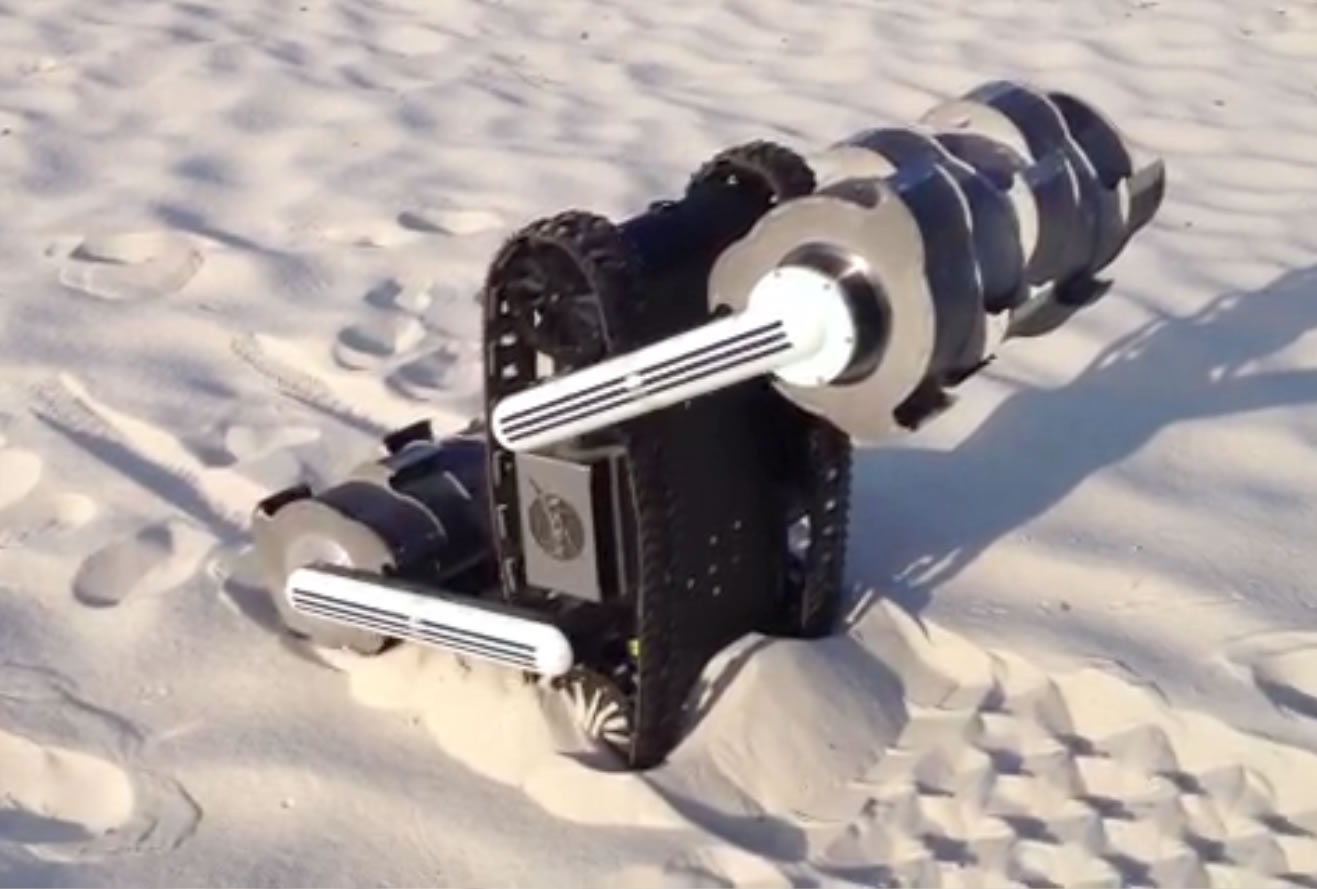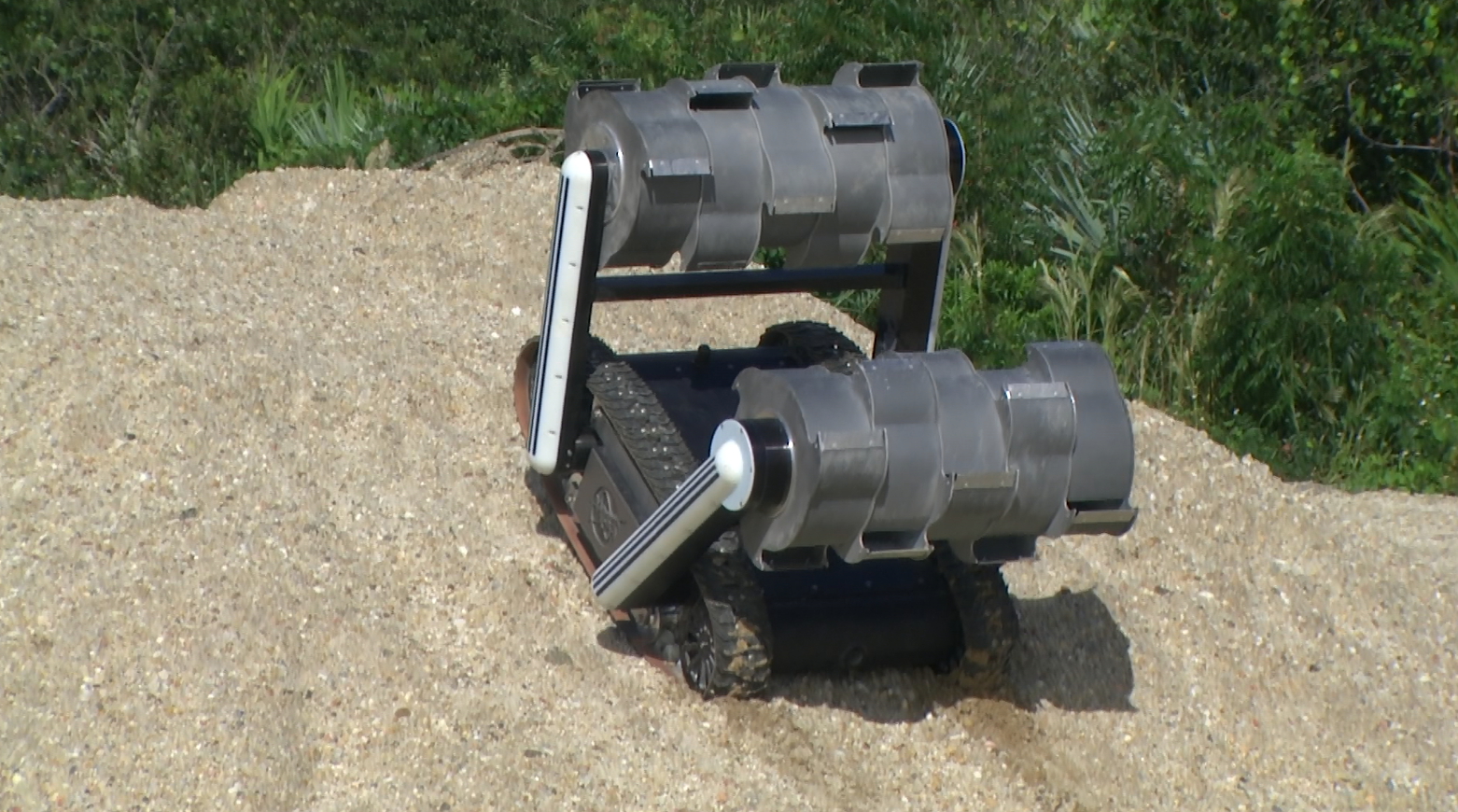The “Regolith Advanced Surface Systems Operations Robot,” shortened to “RASSOR” and aptly pronounced “razor,” is a mining robot being developed by engineers at NASA. The purpose of RASSOR is simple: go to the moon, Mars, and beyond, and excavate their surfaces to find materials that can be converted into supplies for astronomers to use while doing exploratory research.

The RASSOR is able to easily climb over large obstacles.
Possible supplies are wide ranging, but could include fuel, breathing air, and more.
RASSOR background
The team wants to make RASSOR durable enough that it can be relied upon to do work all day, every day, for years on end. No doubt this is a tall task to fulfill; as such, the current bot is nowhere near space-ready. But that doesn’t mean it’s not already showing off some impressive features.
“We were surprised at what we could do with it,” said Rachel Cox, a Kennedy Space Center engineer on the RASSOR team.

With drums on the arms, the RASSOR can change its shape to accomplish particular tasks.
One of the tough things about creating an excavation robot is that it needs to be light enough and small enough to go on a rocket, yet sturdy and stable enough to do the actual excavating.
RASSOR meets these needs using a pretty innovative approach — digging bucket drums at both ends of its body rotate in opposite direction, giving the bot enough traction on one end to allow the opposite side to dig into the soil.
It’s worked pretty well so far: The team tested this design out by building a weight off-loading harness that simulated working in the moon’s 1/6th gravity field.
“We proved that if you engage one bucket, it pulls itself, but when you lower the other bucket and rotate it once they both catch in, it starts digging,” said A.J. Nick, an engineer on the RASSOR team.
Also worth noting about the RASSOR is the staggered shallow scoops. Their purpose is to shave the soil a bit at a time rather than scoop large chunks all at once.

The RASSOR climbing a hill during a recent test.
RASSOR is also incredibly durable. The team points out that the bot can safely drive off the lander and right itself up if it falls down, flip over to get unstuck from the fine soil, and lift its whole body off the ground to let its treads run smoothly (and remove built-up soil).
The RASSOR’s purpose in space
RASSOR by itself, with its drums positioned above the main body of the robot, stands about 2 ½ feet tall. A concept mission for RASSOR would be to include it with a 2,000-pound payload added to the lander (the spacecraft would be about the same size as the Phoenix lander that NASA sent to Mars). The additional components of the payload would be used to process the soil being delivered by RASSOR, extracting water, ice, and chemicals that it can then convert to usable supplies like rocket fuel or breathing air for astronauts working on the surface.
Being able to do this yields some obvious benefits, most notably the amount of expense that would be saved in terms of sending these supplies from Earth. It also makes a mission to Mars more of a reality, especially considering the fact that the planet’s surface is believed to hold large amounts of ice in it.
“This has been kind of the dream, the mission they gear this around,” Nick said. “There are some areas at the poles where they think there's a lot of ice, so you'd be digging in ice,” he adds. “There's other areas where the water is actually 30 centimeters down so you actually have to dig down 30 centimeters and take off the top and that depth is really where you want to start collecting water ice.”
Outlook
As it stands today, in order to provide enough material to create usable resources, the RASSOR would have to operate about 16 hours a day, every day, for five years. It would drive five times faster than the Mars Curiosity rover’s top speed (4 centimeters per second), all the while shaving the moon’s surface with its rotating drum and bringing some 40 pounds of lunar soil for processing back to the resources payload at a time.
“Right now, we just want to make sure nothing in our design precludes it from doing that,” said Jason Schuler, one of the engineers on the RASSOR project. In other words — this is still the early stages of the project.
The team has already begun designing RASSOR-2, a prototype that addresses some of the engineer’s concerns and is closer to what NASA could actually launch someday.
It is expected to begin testing early next year.
Story and images via nasa.gov
Advertisement





